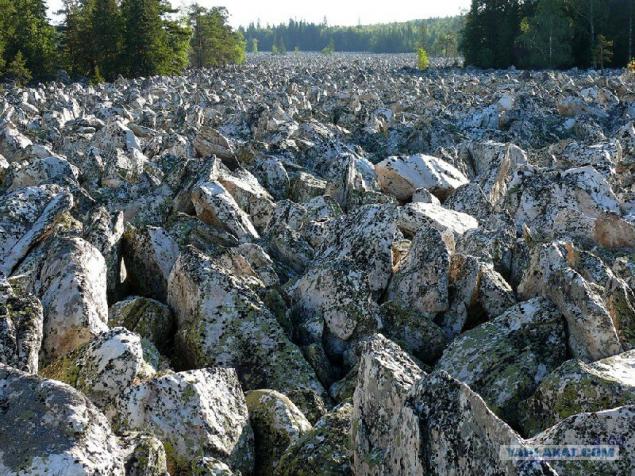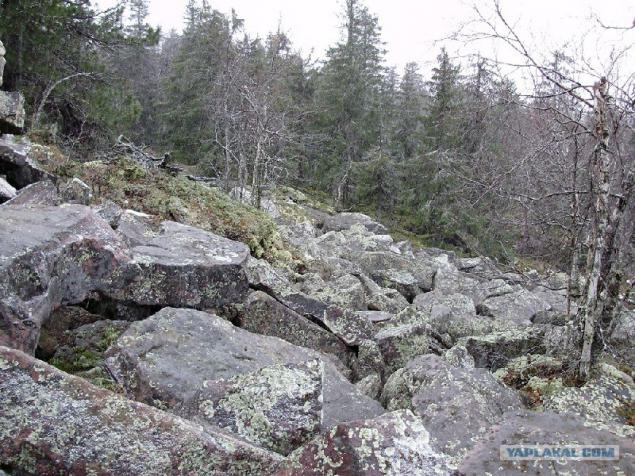638
Where the devil break a leg.
10 pictures and text
Kurumniki, that is to say the stone river abo stone field, many people have seen, but not all comprehended, and many of you, I'm sure, not just to the chagrin of his confusion with moraines of different origin, Kosovo, stopped mudflows, showering and other forms of debris and other coverings stacked stone separately. Among my readers, I suspect (though I did not want to believe it), there are even those for which kurumnik - it is simply piled stones.

The essence of the kurumnika the opinion of learned men, and this is quite simple: it is usually large blocks (statistically sizes in the literature are not defined, but is generally from a few cm in the small diameter of 1-2 m), with sharp broken edges, but never rounded (in motion in a collision with each other and the friction of the underlying surface can acquire a very small roundness) are closed to each other, forming a group in an amount of from a few blocks to tens of thousands or more. Kurumnik may occupy an area of several square meters to the enormous size of fields or "stone sea". In some regions of the Earth kurumniki completely covered stone cover the whole area, forming a kind, nothing on a similar day surface.

Kurumniki usually inhabited complexes of certain types of small animals, they provide refuge from larger predators - a maze of interconnecting passages naturally protected. Large animals, with some exceptions such as Wolverine, to move across the surface kurumnika extremely difficult, and sometimes impossible. As for the people, they are at a meeting with kurumnikami immediately and usually permanently divided into two types: one deftly paced with boulders on the boulder, as if run on a horizontal ladder, others are stepping between boulders, climbs through each or trying to get around - for them kurumnik becomes a chain obstacles, and even one such klishonogy Pester in going on kurumniku group - things torment for the rest.

Kurumniki formed where to the surface out of hard rock. Most often it is a plateau or mountain areas all over the world. One of the first to think about the origin of kurumnikov NM Przewalski and far-fetched that they are formed as a result of destruction of rocks due to uneven heating and cooling, where large amplitude of day and night temperatures, and noted that the intense kurumoobrazovanie passes in the spring and fall for the same reasons. Perhaps continued his thought Nikolai Mikhailovich, cracking rocks can occur when the heated surface of the rocks poured cold rain.

We are sitting on a pile of accumulated since the time of Przewalski's knowledge, we note from a height, that the heating of the rocks during the day in the spring and autumn in areas usually kurumoobrazovaniya not large enough to hiss of rain, but the phase transition - the conversion of water to ice and back again - occurs in offseason regularly, sometimes several times per day. Expands when it freezes, the water penetrated into the cracks of the rock monolith, gradually splits into separate blocks, it - of millimeters and fractions of a millimeter at a time - for years of turning, moving boulders and piles them on each other. It called all this frost weathering. Crushed stone, gruss and other small fragments thus usually fail between large blocks and washed with water down the hillside, exposing the gaps between blocks - here kurumnik.

Eventually kurumnik can grow, increasing in size, gradually move in the underlying surface and occupy a larger and larger area. Sometimes kurumniki form elongated ribbon on the slopes; when the width of these "flows" less than their length, they are called stone rivers. These rivers can slow (or slow - for example, during an earthquake) to move down the slope; described cases progress kurumnikov with a terrible crash in the winter in the mountains north of Eastern Siberia. But they can not move - so called kurumnik dead or asleep.

Sleeping kurumniki sometimes covered by vegetation: first colonized by lichens lumps. Separating the acid, mineral substances are obtained directly from the stone and form roughness on it, and the organic film, which in favorable locations manage to live moss. Where moss - it begins initial soil formation: green pillow gives a foothold and grow the seeds of higher plants, accumulates fertile layer and kurumnik hidden from the eyes. And sometimes, on the contrary, relic kurumniki buried hundreds and even millions of years in the thickness of unconsolidated sediments, due to erosion and weathering may reappear at the surface - even in places where the climate today for their education quite inappropriately.

Stone shallow rivers and seas - the thickness of blocks usually no more than a few meters - but have their own, distinct from the surrounding terrain, climate, hydrology, flora and fauna. According to Russian geomorphology, in Eastern Siberia the depth of penetration of vibrations of daily temperatures in the body kurumnika an average of no more than 0, 5 m, inside not penetrate the sun's rays, it is not blown in the warm winds and a cold accumulator, there may be year-round maintained ice and firn.
Sometimes the kurumnikami in temperate climates formed spots of permafrost. From the melting of snow and firn in the depths kurumnika formed temporary or permanent, changing only the volume of flow depending on the time of day and year, water flows are not visible from the surface, but clearly audible. Merging such flows down the slopes of the mountains come to the surface and form have these streams and even rivers, forming their own bed. Kurumniki even in dry regions have the ability to accumulate in the body and atmospheric moisture surprised travelers can find puddles of water and streams, even near the top of the mountains.

Hydrogeology far can not accurately account for the water balance, taking into account "kurumovyh 'waters; in some places to 20% of groundwater is formed by condensation of atmospheric moisture kurumnikah. This feature was used since ancient times civilization of Asia and the inhabitants of the Crimea - in some areas, creating an artificial covering of rock fragments around the trees, the gardener fully satisfy the necessary moisture and plant watering is not required! Yet there is a wonderful way to create artificial streams in the desert areas: on sloping rocky or clay surface makes extended spout and then throughout its duration pile pyramid stones; atmospheric moisture condenses on the surface of the stone, it runs down and forms a veritable stream of fresh water.

Everything.
© haritonoff

Source:
Kurumniki, that is to say the stone river abo stone field, many people have seen, but not all comprehended, and many of you, I'm sure, not just to the chagrin of his confusion with moraines of different origin, Kosovo, stopped mudflows, showering and other forms of debris and other coverings stacked stone separately. Among my readers, I suspect (though I did not want to believe it), there are even those for which kurumnik - it is simply piled stones.

The essence of the kurumnika the opinion of learned men, and this is quite simple: it is usually large blocks (statistically sizes in the literature are not defined, but is generally from a few cm in the small diameter of 1-2 m), with sharp broken edges, but never rounded (in motion in a collision with each other and the friction of the underlying surface can acquire a very small roundness) are closed to each other, forming a group in an amount of from a few blocks to tens of thousands or more. Kurumnik may occupy an area of several square meters to the enormous size of fields or "stone sea". In some regions of the Earth kurumniki completely covered stone cover the whole area, forming a kind, nothing on a similar day surface.

Kurumniki usually inhabited complexes of certain types of small animals, they provide refuge from larger predators - a maze of interconnecting passages naturally protected. Large animals, with some exceptions such as Wolverine, to move across the surface kurumnika extremely difficult, and sometimes impossible. As for the people, they are at a meeting with kurumnikami immediately and usually permanently divided into two types: one deftly paced with boulders on the boulder, as if run on a horizontal ladder, others are stepping between boulders, climbs through each or trying to get around - for them kurumnik becomes a chain obstacles, and even one such klishonogy Pester in going on kurumniku group - things torment for the rest.

Kurumniki formed where to the surface out of hard rock. Most often it is a plateau or mountain areas all over the world. One of the first to think about the origin of kurumnikov NM Przewalski and far-fetched that they are formed as a result of destruction of rocks due to uneven heating and cooling, where large amplitude of day and night temperatures, and noted that the intense kurumoobrazovanie passes in the spring and fall for the same reasons. Perhaps continued his thought Nikolai Mikhailovich, cracking rocks can occur when the heated surface of the rocks poured cold rain.

We are sitting on a pile of accumulated since the time of Przewalski's knowledge, we note from a height, that the heating of the rocks during the day in the spring and autumn in areas usually kurumoobrazovaniya not large enough to hiss of rain, but the phase transition - the conversion of water to ice and back again - occurs in offseason regularly, sometimes several times per day. Expands when it freezes, the water penetrated into the cracks of the rock monolith, gradually splits into separate blocks, it - of millimeters and fractions of a millimeter at a time - for years of turning, moving boulders and piles them on each other. It called all this frost weathering. Crushed stone, gruss and other small fragments thus usually fail between large blocks and washed with water down the hillside, exposing the gaps between blocks - here kurumnik.

Eventually kurumnik can grow, increasing in size, gradually move in the underlying surface and occupy a larger and larger area. Sometimes kurumniki form elongated ribbon on the slopes; when the width of these "flows" less than their length, they are called stone rivers. These rivers can slow (or slow - for example, during an earthquake) to move down the slope; described cases progress kurumnikov with a terrible crash in the winter in the mountains north of Eastern Siberia. But they can not move - so called kurumnik dead or asleep.

Sleeping kurumniki sometimes covered by vegetation: first colonized by lichens lumps. Separating the acid, mineral substances are obtained directly from the stone and form roughness on it, and the organic film, which in favorable locations manage to live moss. Where moss - it begins initial soil formation: green pillow gives a foothold and grow the seeds of higher plants, accumulates fertile layer and kurumnik hidden from the eyes. And sometimes, on the contrary, relic kurumniki buried hundreds and even millions of years in the thickness of unconsolidated sediments, due to erosion and weathering may reappear at the surface - even in places where the climate today for their education quite inappropriately.

Stone shallow rivers and seas - the thickness of blocks usually no more than a few meters - but have their own, distinct from the surrounding terrain, climate, hydrology, flora and fauna. According to Russian geomorphology, in Eastern Siberia the depth of penetration of vibrations of daily temperatures in the body kurumnika an average of no more than 0, 5 m, inside not penetrate the sun's rays, it is not blown in the warm winds and a cold accumulator, there may be year-round maintained ice and firn.
Sometimes the kurumnikami in temperate climates formed spots of permafrost. From the melting of snow and firn in the depths kurumnika formed temporary or permanent, changing only the volume of flow depending on the time of day and year, water flows are not visible from the surface, but clearly audible. Merging such flows down the slopes of the mountains come to the surface and form have these streams and even rivers, forming their own bed. Kurumniki even in dry regions have the ability to accumulate in the body and atmospheric moisture surprised travelers can find puddles of water and streams, even near the top of the mountains.

Hydrogeology far can not accurately account for the water balance, taking into account "kurumovyh 'waters; in some places to 20% of groundwater is formed by condensation of atmospheric moisture kurumnikah. This feature was used since ancient times civilization of Asia and the inhabitants of the Crimea - in some areas, creating an artificial covering of rock fragments around the trees, the gardener fully satisfy the necessary moisture and plant watering is not required! Yet there is a wonderful way to create artificial streams in the desert areas: on sloping rocky or clay surface makes extended spout and then throughout its duration pile pyramid stones; atmospheric moisture condenses on the surface of the stone, it runs down and forms a veritable stream of fresh water.

Everything.
© haritonoff

Source:
























